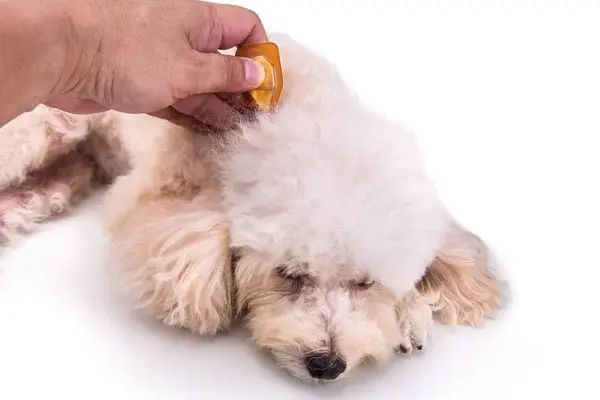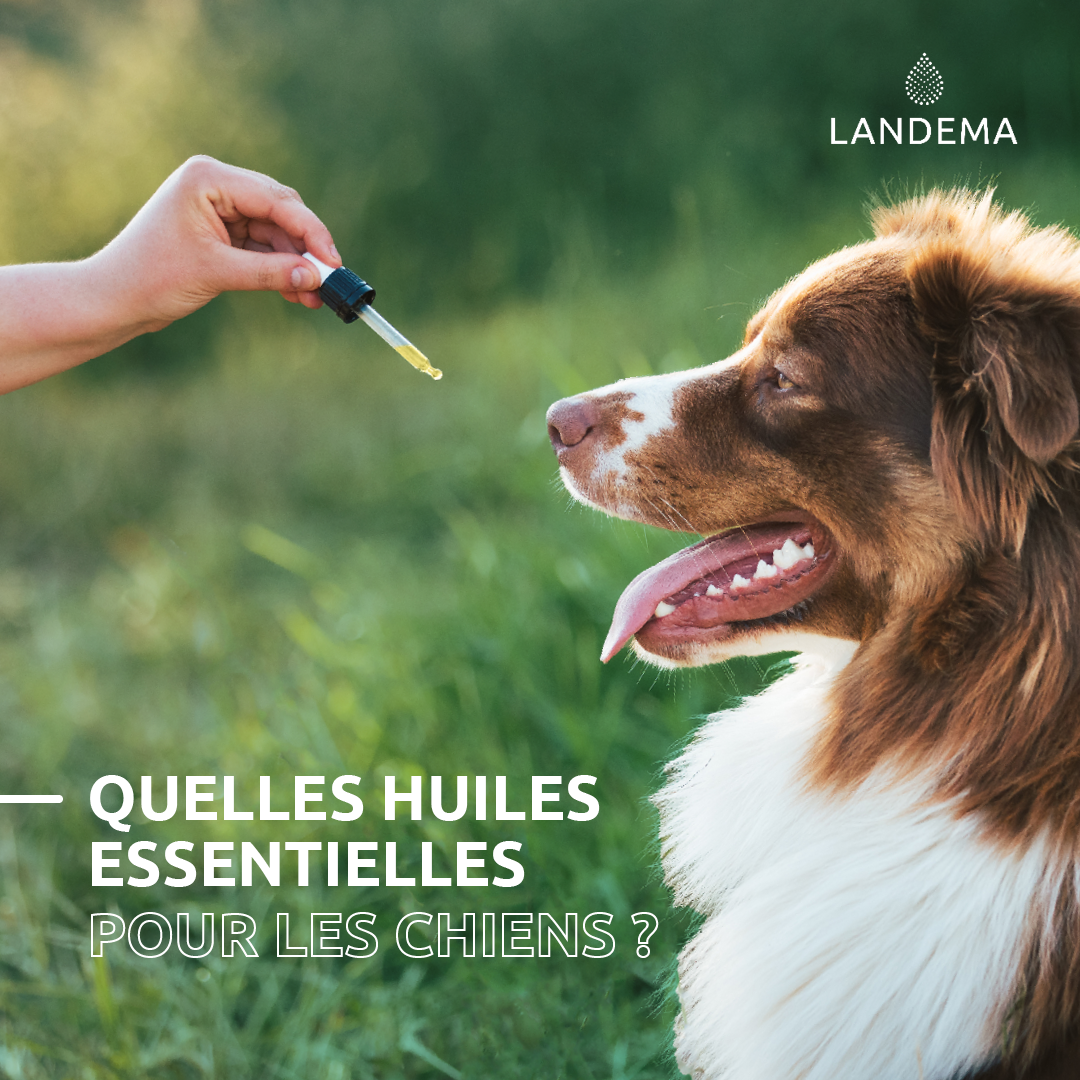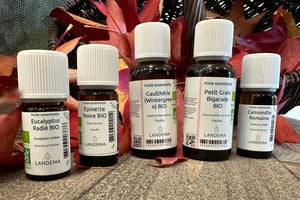Essential oils for dogs: therapeutic protocols

January 30, 2023
What essential oils can we use on dogs?
While aromatherapy is an interesting alternative to allopathic treatments for humans, it can also be applied to animals. In fact, certain essential oils have been used for decades to combat parasites in hens and horses. However, in the following lines, we'll focus on pets, and tell you which essential oils can be used on dogs.
Precautions to take
Before treating a dog with aromatherapy, it's important to heed the following advice:
- Choose essential oils of impeccable quality; because animals are very sensitive to aromatic molecules, it's very important to choose essential oils that are 100% pure, natural and integral.
- Never administer pure essential oils orally; they must be diluted (in the vegetable oil of your choice, honey or even a neutral tablet) to avoid irritating the oral and gastric mucosa.
- Avoid all contact of essential oils with mucous membranes (nose, lips, ears, ano-genital area) and with the eyes and their surroundings. In the event of contact, rinse with milk or vegetable oil. In this case, water will not only be ineffective, it will aggravate the problem.
- If used pure on the skin, avoid choosing essential oils that are photosensitizing, dermocaustic or allergenic.
- Avoid using essential oils containing ketones, which may cause convulsions. To avoid this risk, avoid the following essential oils:
- Atlantic Cedar (Cedrus atlantica),
- Peppermint (Mentha x piperita),
- Spearmint (Mentha spicata),
- Rosemary camphor (Rosmarinus officinalis camphoriferum),
- Rosemary verbenone (Rosmarinus officinalis verbenoniferum)
- and Sage (Salvia officinalis).
- Do not use essential oils on puppies under 3 months of age or on pregnant or nursing females.
- Always carry out a test on a small area to check that the dog is not allergic to the essential oil.
- If in doubt about the use of an essential oil, its method of administration and possible contraindications, refer to a veterinarian.

How to administer essential oils to a dog
On the skin
While there are many different ways toadminister essential oils to a dog, one of the most common is via the skin. Essential oils are lipophilic and penetrate the animal's skin very well. You can choose to use pure essential oils, provided they are not dermocaustic, photosensitizing or allergenic, as mentioned in the precautions above.
You'll need to choose an area where the dog won't be able to lick (neck, spine), and massage in the wrong direction.
If you wish to dilute the essential oils, vegetable oils are not the best medium here, due to the thickness of the coat. Instead, dilute them in a non-greasy gel (2-15%) or in an appropriate shampoo (0.5-3%).
Internal use
It is possible to administer essential oils to a dog orally, but diluted. This can be in vegetable oil at 5-20%, in honey (if it's liquid, a dilution of up to 8% is possible, and up to 25% in creamy honey), or on a neutral tablet. If you choose the latter solution, it will be for a maximum of 3 drops, and you'll need to administer the tablet in such a way that the dog doesn't chew it, to avoid irritating its internal mucous membranes.
You can also include essential oils in your pet's food. If it's fresh food, you can mix 1 to 3 drops directly into the pâté or meatball. For dry kibbles, dilute a few drops of essential oils in vegetable oil, spread them over the kibbles and wait for them to be fully absorbed before offering them to the dog.
By diffusion
The third way to give your dog the benefits of essential oils is to diffuse them in the air, always taking the precaution of diluting them beforehand. This method of administration is particularly suitable for respiratory disorders. To do this, use a suitable electric diffuser to avoid heating the essential oil, which would permanently alter its properties, and follow the diffuser's instructions for use.
Isolate the dog in a small, closed room and diffuse for 15 to 20 minutes, until the aromatic molecules saturate the air and gradually take effect.
For even more tips, don't hesitate to follow us on our instagram and facebook social networks.
What essential oils can I use on a dog?
Anti-parasite essential oils
If there's one problem most dogs face, it's parasites, particularly fleas and ticks. To get rid of them, use Tea Tree(Melaleuca alternifolia) and True Lavender (Lavandula angustifolia) essential oils. You can add Eucalyptus citronné (Eucalyptus citriodora) essential oil, which is also repellent.
For both prevention and treatment, apply the following to your dog's collar:
- 3 drops of True Lavender (Lavandula angustifolia)
- 3 drops Tea Tree (Melaleuca alternifolia)
- 1 drop of Lemon Eucalyptus (Eucalyptus citriodora)
Repeat every week.
Essential oils for skin infections
Parasites can irritate your pet's skin, sometimes to the point of infection. Here again, you can use essential oils such as Roman chamomile(Chamaemelum nobilis) or noble laurel(Laurus nobilis). The anti-inflammatory properties of the former are also very useful for burns and allergic reactions. The latter is an excellent anti-infective.
Essential oils for dogs' digestive problems
Theuse of essential oils for a dog will also prove beneficial if he or she is prone to digestive problems. In this case, you can opt for Cinnamon essential oil(Cinnamomum verum), which will eliminate worms in particular, a real disrupter of the animal's transit. Basil essential oil(Ocimum basilicum var. basilicum), on the other hand, is more likely to help with gastric disorders and diarrhoea.
Essential oils for viral infections
Essential oils can also beused to treat dogs susceptible to viral infections such as bronchitis, nasopharyngitis or kennel cough. Ravintsara essential oil(Cinnamomum camphora sb 1,8-cineole) is renowned for its antiviral and expectorant properties. What's more, if your pet is feeling a bit under the weather, this oil's stimulating properties can also give it a boost.
These are just a few examples of ailments in dogs for which essential oils are fast-acting, effective and have no side effects. Remember that to do this, you need to choose the highest quality essential oils, such as those we offer at Landema. For more information,please refer to the article What makes an essential oil good?
This information has been taken from recognized books and traditional uses, and Landema cannot be held responsible for any errors or omissions. Landema's responsibility is limited to the information and instructions given on the labels and documents supplied with our products. In case of doubt or problem, consult a specialist.
Sources: Guide pratique d'Aromathérapie chez l'animal de compagnie by Pascal Debauche and Dominique Baudoux and Article in the Guilde des herboristes du Québec magazine by Stéphanie Plamondon.



